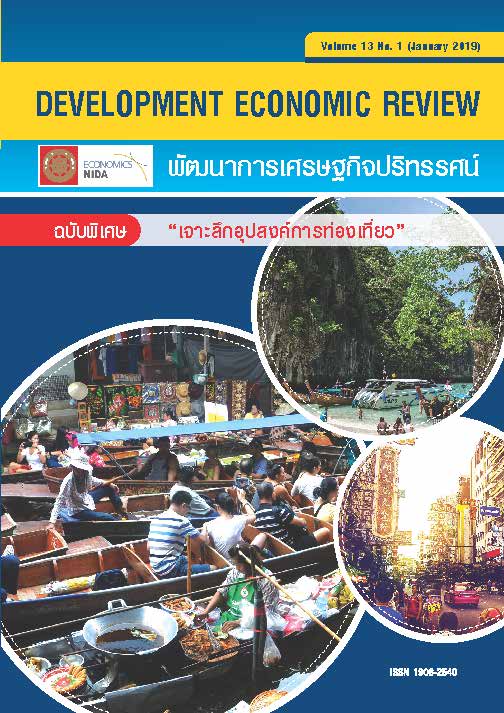Price Discrimination against Tourists: Is It Ethical?
Keywords:
Price Discrimination, Business Ethices, Tourist, Perceived Fairness, ThailandAbstract
Thailand is renowned as one of the world’s most popular tourist destinations; yet, its reputation has been tarnished by the pervasive overcharging of foreign tourists. Theoretically though, price discrimination as a means of maximizing profits is possible when consumers can be grouped according to price elasticities; in this case, locals versus tourists. This study aims to explore the ethical perceptions of price discrimination, from the perspective of the stakeholders involved in the tourism sector of Thailand. Results indicate that price discrimination itself is viewed as being neither ethical nor unethical, it depends on the underlying motives and the nature of the situation. For example, the practice of price discrimination is more acceptable if its motive is for the survival of the business, or when the practice is focused on wealthy tourists. It is the framing, and the intensity of the price difference, however, that play important roles in the ethical perceptions of price discrimination.
References
Adam, J.S. (1965). Inequity in social exchange. In Advances in Experimental Social Psychology, Vol. 2, L. Berkowitz, ed. New York: Academic Press, 267-299.
Bangkok Post. (2014, March 19). Tourism income to hit B2.42 Trillion. Bangkok Post. Retrieved September 1, 2015, from https://www.bangkokpost.com/most-recent/400701/ tourism-as-gdp-to-rise-by-0-1-in-2014.
Baumol, W.J. & Swanson, D.G. (2003). The new economy and ubiquitous competitive price discrimination: Identifying defensible criteria of market power. Antitrust Law Journal, 70(3), 661-685.
Campbell, M.C. (1999). “Why did you do that?” The important role of inferred motive in perceptions of price fairness. Journal of Product & Brand Management, 8(2), 145-152.
Carlton, D.W. &Perloff, J.M. (2005). Modern industrial organization, 4th Edition. Pearson.
Chen, S.S., Monroe, K. B., & Lou, Y. (1998). The effects of framing price promotion messages on consumers’ perceptions and purchase intentions. Journal of Retailing, 74(3), 353-372.
Chinmaneewong, C. &Arunmas, P. (2015, May 18). Swift action urged against overpriced restaurant. Bangkok Post. Retrieved September 1, 2015, from https://www. bangkokpost.com/news/general/564995/swift-action-urged-against-overpriced-restaurant.
Elegido, J.M. (2011). The ethics of price discrimination. Business Ethics Quarterly, 21(4), 633-660.
Homans, G.C. (1961). Social behavior: Its elementary forms. New York: Harcourt, Brace & World.
Kahneman, D., Knetsch, J.L., &Thaler, R.H. (1986). Fairness as a constraint on profit seeking: entitlements in the market. American Economic Review, 76(4), 728-741.
Kahneman, D. &Tversky, A. (1979). Prospect theory: An analysis of decision under risk. Econometrica, 47(2), 263-292.
Kimes, S.E. (1994). Perceived fairness of yield management. Cornell Hotel and Restaurant Administration Quarterly, 29(1), 22-29.
Kimes, S.E. (2002). Perceived fairness of yield management: An update. Cornell Hotel and Restaurant Administration Quarterly, 43(1), 21-30.
Kimes, S.E. andWirtz, J. (2003). Has revenue management become acceptable? Journal of Service Management, 6(2), 125-135.
Marcoux, A.M. (2006). Much ado about price discrimination. Journal of Markets & Morality, 9(1): 57-69.
Martins, M. & Monroe, K.B. (1994). Perceived price fairness: A new look at an old construct. In Advances in consumer research, Vol. 21, eds. Chris T. Allen and Deborah Roedder John, 75-78.
Pepall, L., Richards, D., & Norman, G. (2008). Industrial organization: contemporary theory and empirical applications. Blackwell Publishing.
Puller, S.L. & Taylor, L.M. (2012). Price discrimination by day-of-week of purchase: evidence from the U.S. airline industry. Journal of Economic Behavior & Organization, 84(2012), 801-812.
Schmalensee, R. (1981). Output and welfare implications of monopolistic third-degree price discrimination. American Economic Review, 71(1), 242-247.
Thaler, R.H. (1985). Mental accounting and consumer choice. Marketing Science, 4(3), 199-214.
Thibaut, J.W. & Walker, L. (1975). Procedural justice: A psychological analysis. Hillsdale, NJ: Lawrence Erlbaum Associates.
The Nation. (2014, September 4). Dual-pricing is scaring tourists away. The Nation. Retrieved September 1, 2015 from https://www.nationmultimedia.com/opinion/ Dual-pricing-is-scaring-tourists-away-30242446.html.
Varian, H. (1985). Price discrimination and social welfare. American Economic Review, 75(4), 870-875.
Wirtz, J. &Kimes, S.E. (2007). The moderating role of familiarity in fairness perceptions of revenue management pricing. Journal of Service Research, 9(3), 229-240.
Wood, J.V. (1989). Theory and research concerning social comparisons of personal attributes. Psychological Bulletin, 106(2), 231-248.
Xia, L., Monroe, K.B., & Cox, J.L. (2004). The price is unfair! A conceptual framework of price fairness perceptions. Journal of Marketing, 68(4), 1-15.
Downloads
Published
Issue
Section
License
Copyright to published manuscripts becomes the property of the Graduate School of Development Economics, National Institute of Development Administration. Reproduction of all or part of a Development Economic Review (DER) article by anyone, excluding author(s), is prohibited, unless receiving our permission.
Disclaimer: Opinions expressed in articles published in this journal are those of the author (s) and do nto necessarily represent opinions of the Graduate School of Development Economics, National Institute of Development Administration. Trade and proprietary names are only for identification and not constitute our endorsement.


